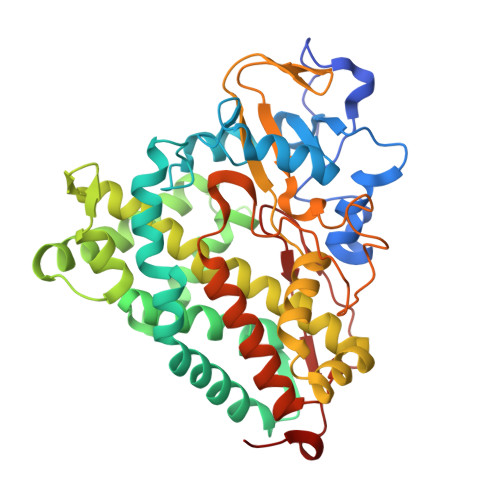Effect of Redox Partner Binding on Cytochrome P450 Conformational Dynamics.
Batabyal, D., Richards, L.S., Poulos, T.L.(2017) J Am Chem Soc 139: 13193-13199
- PubMed: 28823160
- DOI: https://doi.org/10.1021/jacs.7b07656
- Primary Citation of Related Structures:
5WK7, 5WK9 - PubMed Abstract:
Previous crystal structures of cytochrome P450cam complexed with its redox partner, putidaredoxin (Pdx), shows that P450cam adopts the open conformation. It has been hypothesized that the Pdx-induced shift toward the open state frees the essential Asp251 from salt bridges with Arg186 and Lys178 so that Asp251 can participate in a proton relay network required for O 2 activation. This in part explains why P450cam has such a strict requirement for Pdx. One problem with this view is that looser substrate-protein interactions in the open state may not be compatible with the observed regio- and stereoselective hydroxylation. In the present study, molecular dynamics simulations show that Pdx binding favors a conformation that stabilizes the active site and decreases camphor mobility yet retains a partially open conformation compatible with the required proton relay network. The R186A mutant which frees Asp251 in the absence of Pdx retains good enzyme activity, and the crystal structure shows that product, 5-exo-hydroxycamphor, is bound. This indicates that rupture of the Asp251-Arg186 relaxes selectivity with respect to source of electrons and enables X-ray generated reducing equivalents to support substrate hydroxylation. These combined computational and experimental results are consistent with the proposed role of Pdx in assisting the release of Asp251 from ion pairs so that it can participate in proton-coupled electron transfer.
Organizational Affiliation:
Departments of Molecular Biology and Biochemistry, Pharmaceutical Sciences, and Chemistry, University of California , Irvine, California 92697-3900, United States.

















